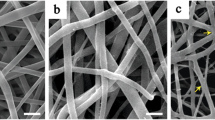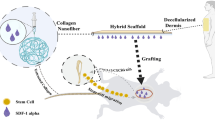Abstract
The aim of the present study was to compare one-step method to EDC/NHS crosslinking (EDC/NHS group) and one-step simultaneous method to EDC/NHS crosslinking and heparin immobilization (EDC/NHS- Heparin group) in improving physiochemical and biological properties of native collagen sponge (Control group). Modified collagen sponge overcome the disadvantages of native collagen sponge. IR spectra suggest the change of the functional groups. DSC data indicate that the stability of caloric transformation in EDC/NHS group is slightly higher than that of EDC/NHS-Heparin group. The crosslinking degree, stability against enzymes, stability in morphologically and biomechanical properties of EDC/NHS-Heparin group are higher than those of EDC/NHS group, whereas, the water-binding capacity in EDC/NHS-Heparin group is lower than that of EDC/NHS group. HUVECs in EDC/NHS-Heparin group scaffold proliferate fast, migrate well and distribute uniformly. One-step simultaneous method gains the better effects in above aspects, heparinized collagen matrices increase in angiogenic potential and suit for defect repairing and tissue engineering.
Similar content being viewed by others
References
Pieper JS, Hafmans T, van Wachem PB, et al. Loading of Collagen-heparan Sulfate Matrices with bFGF Promotes Angiogenesis and Tissue Generation in Rats[J]. Biomed. Mater. Res., 2002, 62: 185–194
Patel ZS, Mikos AG. Angiogenesis with Biomaterial-based Drug and Cell-delivery Systems[J]. Biomater Sci. Polym. Ed., 2004, 15: 701–726
Hughes GC, Biswas SS, Yin B, et al. Therapeutic Angiogenesis in Chronically Ischemic Porcine Myocardium: Comparative Effects of bFGF and VEGF[J]. Ann. Thorac. Surg., 2004, 77: 812–818
Michael J. Salibar J. Heparin in the Treatment of Burns[J]. Burns, 2001, 27: 349–358
Fukuda S, Yoshii S, Kaga S, et al. Angiogenic Strategy for Human Ischemic Heart Disease: Brief Overview[J]. Mol. Cell Biochem., 2004, 264: 143–149
Bennett SP, Griffiths GD, Schor AM, et al. Growth Factors in the Treatment of Diabetic Foot Ulcers[J]. Br. J. Surg., 2003, 90: 133–146
Zbigniew Ruszczak, Wolfgang Friessc. Collagen as a Carrier for on-site Delivery of Antibacterial Drugs[J]. Advanced Drug Delivery Reviews, 2003, 55: 1679–1698
Keiji Fujioka, Miho Maeda, Takami Hojo, et al. Protein Release from Collagen Matrices[J]. Advanced Drug Delivery Reviews, 1998, 31: 247–266
Akihiro Kanematsu, Akira Marui, Shingo Yamamoto, et al. Type I Collagen can Function as a Reservoir of Basic Fibroblast Growth Factor[J]. Journal of Controlled Release, 2004, 99: 281–292
Di Lullo GA, Sweeney SM, Korkko J, et al. Mapping the Ligand-binding Sites and Disease-associated Mutations on the most Abundant Protein in the Human Type I Collagen[J]. Biol. Chem., 2002, 277: 4223–4231
Hiroki Ueda, Liu Hong, Masaya Yamamoto, et al. Use of Collagen Sponge Incorporating Transforming Growth Factor-β1 to Promote Bone Repair in Skull Defects in Rabbits[J]. Biomaterials, 2002, 23: 1003–1010
Qiang Lu, Shenjia Zhang, Kun Hua, et al. Cytocompatibility and Blood Compatibility of Multifunctional Fibroin/Collagen/Heparin Scaffolds[J]. Biomaterials, 2007, 28: 2306–2313
MJB Wissink, R Beernink, AA Poot, et al. Improved Endothelialization of Vascular Grafts by Local Release of Growth Factor from Heparinized Collagen Matrices[J]. Journal of Controlled Release, 2000, 64: 103–114
MASAYA NAKAMURA, JUN WATANABE, RYOKEI OGAWA, et al. Immunohi- stochemical Localization of Type II and Type I Collagens in Articular Cartilage of the Femoral Head of Dexamethasone-treated Rats[J]. Histochemical Journal, 1997, 29: 645–654
Zenon Grabarek, John Gergely. Zero-length Crosslinking Procedure with the Use of Active Esters[ABC] [J]. Biophys. J., 1988, 53: 392
Peter Angelea, Jochen Abke, Richard Kujata, et al. Influence of Different Collagen Dpecies on Physico-chemical Properties of Crosslinked Collagen Matrices[J]. Biomaterials, 2004, 25: 2831–2841
Tse-Wei Yue, Wei-Che Chien, S-Ja Tseng, et al. EDC/NHS-mediated Heparinization of Small Intestinal Submucosa for Recombinant Adeno-associated virus Serotype 2 Binding and Transduction[J]. Biomaterials, 2007, 28: 2350–2357
Moon Suk Kim, Keum Duck Hong, Hye Won Shin, et al. Preparation of Porcine Small Intestinal Submucosa Sponge and Their Application as a Wound Dressing in Full-thickness Skin Defect of Rat[J]. International Journal of Biological Macromolecules, 2005, 36: 54–60
MJB Wissink, R Beernink, JS Pieper, et al. Immobilization of Heparin to EDC/NHS-crosslinked Collagen. Characterization and in vitro Evaluation[J]. Biomaterials, 2001, 22: 151–163
Chang Yao, Martin Roderfeld, Timo Rath, et al. The Impact of Proteinase-induced Matrix Degradation on the Release of VEGF from Heparinized Collagen Matrices[J]. Biomaterials, 2006: 27: 1608–1616
JS Pieper, T Hafmans, JH Veerkamp, et al. Development of Tailor-made Collagen-glycosam Inoglycan Matrices: EDC/NHS Crosslinking, and Ultrastructural Aspects[J]. Biomaterials, 2000, 21: 581–593
Dimitar Stamov, Milauscha Grimmer, Katrin Salchert, et al. Heparin Intercalation into Reconstituted Collagen I Fibrils: Impact on Growth Kinetics and Morphology[J]. Biomaterials, 2008, 29: 1–14
SM Sweeney, A Verrecchio, C Fields, et al. Type I Collagen-heparin Interactions in Angiogenesis[C]. The Seventeenth Annual Meeting of the East Coast Connective Tissue Society: 131
MJB Wissink, R Beernink, JS Pieper, et al. Binding and Release of Basic Fibroblast Growth Factor from Heparinized Collagen Matrices[J]. Biomaterials, 2001, 22: 2291–2299
Peter Angelea, Jochen Abke, Richard Kujata, et al. Influence of Different Collagen Species on Physico-chemical Properties of Crosslinked Collagen Matrices[J]. Biomaterials, 2004, 25: 2831–2841
Kwangwoo Nam, Tsuyoshi Kimura, Akio Kishida. Physical and Biological Properties of Collagen-phospholipid Polymer Hybrid Gels[J]. Biomaterials, 2007,28: 3153–3162
Bubnis WA, Ofner CM. The Determination of Epsilon-amino Groups in Soluble and Poorly Soluble Proteinaceous Materials by Aspectrophotometric Method Using Trinitrobenzenesulfonic Acid[J]. Anal. Biochem., 1992, 207: 129–33
L Buttafocoa, NG Kolkmana, P Engbers-Buijtenhuijsa, et al. Electrospinning of Collagen and Elastin for Tissue Engineering Applications[J]. Biomaterials, 2006, 27: 724–734
WU Ji Min, GUAN Jing, ZHANG Xi zheng. Structural Analysis and Physicochemical Properties of the Collagen Sponge[J]. Chinese J. Biomed. Eng. Vol., 2003, 12: 126–132
CS Chen, IV Yannas, M Spector. Pore Strain Behaviour of Collagen Glycosaminoglycan Analogues of Extracellular Matrix[J]. Biomaterials, 1995, 16: 777–783
Zuwei Ma, Changyou Gao, Yihong Gong, et al. Cartilage Tissue Engineering PLLA scaffold Withsurface Immobilized Collagen and Basic Fibroblast Growth Factor[J]. Biomaterials 2005, 26: 1253–1259
MJB Wissink, R Beernink, NM Scharenborg, et al. Endothelial Cell Seeding of (heparinized) Collagen Matrices: Effects of bFGF Pre-loading on Proliferation (after Low Density Seeding) and Pro-coagulant Factors[J]. Journal of Controlled Release, 2000, 67: 141–155
Mingyan Yan, Bafang Li, Xue Zhao, et al. Characterization of Acid-soluble Collagen from the Skin of Walleye Pollock (Theragra chalcogramma) [J]. Food Chemistry, 2008, 107: 1581–1586
XH Wang, DP Lia, WJ Wang, et al. Crosslinked Collagen/Chitosan Matrix for Artificial Livers[J]. Biomaterials, 2003, 24: 3213–3220
Amira Bouafsoun, Laurence Ponsonnet, Abdelhamid Kerkeni, et al. Comparative Wettability Study of Polystyrene Functionalized with Different Proteins[J]. Materials Science and Engineering C, 2007, 27: 709–715
Author information
Authors and Affiliations
Corresponding author
Additional information
Funded by the National Natural Science Foundation of China (10832012) and the Natural Science Foudation of Tianjin city(08JCYBJC03400)
Rights and permissions
About this article
Cite this article
Xu, Y., Wu, J., Guan, J. et al. Physiochemical and biological properties of modified collagen sponge from porcine skin. J. Wuhan Univ. Technol.-Mat. Sci. Edit. 24, 619–626 (2009). https://doi.org/10.1007/s11595-009-4619-2
Received:
Accepted:
Published:
Issue Date:
DOI: https://doi.org/10.1007/s11595-009-4619-2




